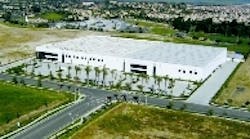Sometimes landing a big contract is what pushes a company to make the decision to move to a larger facility. That's what Ashworth Inc. (Carlsbad, Calif.) decided when it acquired the license from Calloway Golf Co. (Carlsbad, Calif.) to design, embroider and distribute its branded apparel.
Ashworth imports, manufactures and distributes golf and other apparel for men and women. Products are distributed through pro shops, high-end retailers, corporate logo programs and a website. The company's 2005 sales were just under $205 million.
The company had been at its existing facility for 10 years and had no room to grow. Ashworth managers decided to do more than buy the land in Oceanside, Calif., and build a 160,000-sq.-ft. facility with a 40,000-sq.-ft. mezzanine. They saw the move as an opportunity to make its embroidery process faster and more efficient.
Since embroidering is labor-intensive, managers realized that if the company did not automate and streamline its processes, labor would become a large component of the company's total costs. "Labor is a large issue because we embroider so many shirts. We didn't want to outstrip the local labor market," explains Matt Peters, v.p. of distribution. Automation was the answer.
Ashworth hired material handling consultant, Sigman Kaiden Consulting Inc. (East Northport, N.Y.) to design-a new embroidery process, choose automation equipment, and work with the architect to create a building tailored to Ashworth's new process.
Embroidery requires fabric to be placed in a hoop with a felt-like backing material to hold the stitches in place. After the logos are stitched, the excess backing is trimmed. When Sigman Kaiden consultants looked at Ashworth's old process, they found embroidery machines waiting for an operator while operators performed manual tasks such as hooping, unhooping and trimming.
In the new process, reusable radiofrequency identification (RFID) tags reduce setup time and maximize equipment use. A new automatic garment carrier system uses information on each garment's RFID tag to take it to and from the mezzanine where manual prep and finish work is done. The proprietary software system routes garments to the different stations or to random-access material buffers that hold them until they can be delivered to open embroidery machines. The RFID tags are only used internally. They're removed for reuse before items are shipped.
The RFID-enabled system has enabled Ashworth to switch from a batch to process flow. Formerly, batches included different sizes, colors and styles of shirts that were delivered to an embroidery machine with written work instructions. The operator was responsible for figuring out the thread colors to order from the 500-color thread library, which embroidery head to put the color on, and which shirts needed to be stitched with that color. Now, sizes, colors and logo styles are grouped, along with the appropriate thread colors, and routed to the embroidery machine that best matches the colors and the size of the run.
It is a paperless process. The software calculates the most efficient work for each machine on an ongoing basis and sends garments to those machines. Terminals at each embroidery machine give operators the information they need to do the work.
After embroidery, the garments are automatically carried back to the mezzanine, the hoops are removed and the logos' felt backing and extra stitches are manually trimmed. A fair amount of the embroidery process is still manual, Peters says. "It was necessary to retain the manual part of the embroidery process because shirts vary dramatically among different styles and manufacturers." However, he adds, "We took all of the things that could be automated and automated them." And the labor savings offset the cost of the automation.
Over the 10 year period in its prior facility, Ashworth had reduced the time it takes to embroider and ship apparel to customers from 20 to 2.5 days. Response time in its new building, which went live in 2005, is less than a half-day. Customers can now place an order today that will ship tomorrow.
In the new building, when cartons are pulled, they are put into bar-coded totes that travel on an FKI Logistex conveyor system. Garments that will not be embroidered are sent to a pick-to-light, put-to-light carousel on the conveyor. The carousels have automatic extractors that pick the fastest moving SKUs; 70% of picks are done hands-free. Picked garments are put into shipping cartons. Full shipping cartons are sent to the tagging area where customer price tags are applied to each garment.
Efficiency and automation have enabled Ashworth to almost quadruple its production rates during golf's busy spring, summer and fall seasons.
Automation and streamlined processes lower the handicap of Ashworth Inc.




